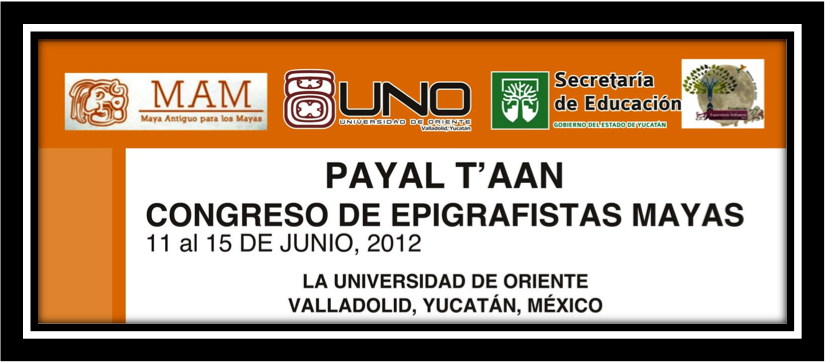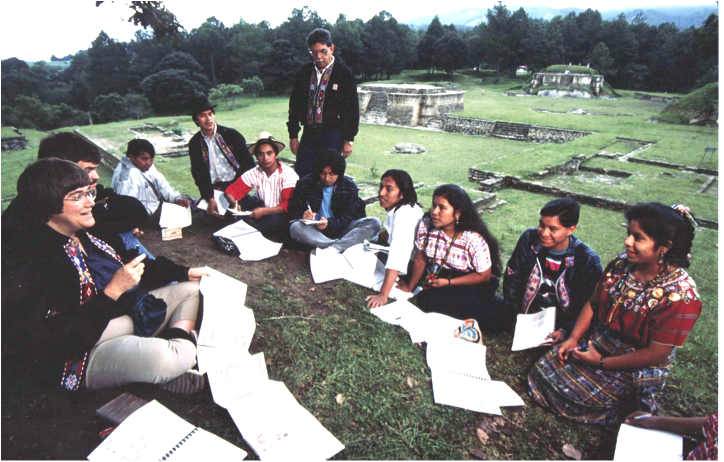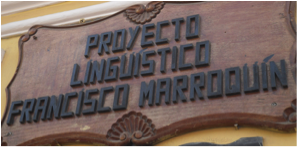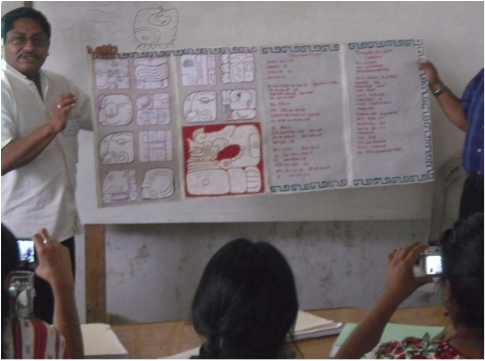Announcing the first international Congress of Maya Epigraphers (Congreso de Epigrafistas Mayas).
In June, 2012, the University of the Orient in Valladolid (UNO), Educación Indígena of the State of Yucatán and Mayas for Ancient Mayan (MAM) will co-host an event of historic proportions.
Some 80 invited Maya scholars and students from Guatemala, Belize and Mexico will gather in Valladolid, Yucatán, for a week of workshops, lectures, and special events focused on the ancient writing.
Se anuncia el primer congreso internacional de epigrafistas mayas (Congreso de Epigrafistas Mayas).
En Junio de 2012, la Universidad de Oriente (UNO) de Valladolid, Educación Indígena del Estado de Yucatán y Maya Antiguo para los Mayas (MAM) co-organizarán un evento de dimensiones históricas.

Se ha invitado a unos 80 estudiosos y estudiantes mayas de Guatemala, Belice y México a reunirse en Valladolid, Yucatán durante una semana, en el curso de la cual se darán talleres, conferencias y eventos especiales en torno a la escritura antigua.
[The event is closed and by invitation only due to considerations of space, budget, controllability and other factors. Those of you who are not invited but have the desire to learn can be in contact with those who do attend, who are committed to holding workshops and classes in the coming weeks, months and years in their communities.]
We at MAM see ourselves directly in line with Linda Schele, Kathryn Josserand, Federico Fahsen, Nick Hopkins, Nikolai Grube, and other pioneers in making Maya hieroglyphic writing and the calendar accessible to the indigenous Maya.
The first glyph workshop for Mayas, as far as we can reconstruct, was held in Antigua, Guatemala, July 20-22, 1987. Kathryn Josserand, Nick Hopkins, and Linda Schele held forth in front of more than two dozen indigenous Maya students representing seven Maya languages and five Guatemalan institutions (see History on our web site https://discovermam.org/history/).

Unknown date. The participants from left to right are: Linda Schele, Nikolai Grube, unknown (white shirt), Saqchen Ruperto Montejo (black hat), Pedro Florencio Tuch Pum (white hat), Federico Fahsen (standing), Pakal B'alam José Obispo Rodríguez Guaján, Lolmay Pedro García Matzar, Nikte Maria Juliana Sis Iboy, unknown, Saqijix Candelaria Dominga López Ixcoy

2003: Kathryn Josserand and students in Chimaltenango at a workshop given for OKMA (Oxlajuj Keej Maya Ajtz'ib'). From left to right. Héctor Xol Chok (Q’eqchi’), Filiberto Patal (Kaqchikel), Antonio Cuxil (Kaqchikel), Beatriz Par (K’iche’), Kathryn Josserand, Sonia Raymundo Gonzáles (Q’anjob’al), Romelia Mo (Poqomchi’), Edna Patricia Delgado (Popti’), Jeventino de Jesús Pérez (Mam)
Nikolai Grube deserves special mention. He has been coming to Guatemala for many years at his own expense to give annual workshops for Maya epigraphers.
Thanks to these leaders and others, a number of Maya scholars have been conducting their own workshops in recent years, as reported on www.discovermam.org and elsewhere. These classes, by Maya for Maya, are at the core of our new thrust to make reading the glyphs available to the widest possible Maya audience.
 In 2010, MAM (then known as Friends of the Maya) co-sponsored a weekend workshop in Antigua with Proyecto Linguístico Francisco Marroquín that included Friends of the Maya colleagues and Maya scholars invited by PLFM from all over Guatemala.
In 2010, MAM (then known as Friends of the Maya) co-sponsored a weekend workshop in Antigua with Proyecto Linguístico Francisco Marroquín that included Friends of the Maya colleagues and Maya scholars invited by PLFM from all over Guatemala.

Guatemalan Maya K’iche’ school teachers record lessons from Yucatán school teacher Crisanto Kumul on their cameras to share in their own communities. (Crisanto is one of the hosts and organizers for the upcoming Congreso.)
Now, in 2012, we are taking this movement to a whole new level. Some 80 Maya scholars, teachers, and students from throughout the contemporary Maya world will gather their resources and strengthen their commitments giving rise to ever-expanding networks of Maya scholars. What a joy to witness this growth, nay, explosion of epigraphic energy.

[Por restricciones de espacio, presupuesto, facilidad de control y otros factores, se trata de un evento cerrado, al que es posible acudir sólo mediante invitación. Aquellos que no hayan sido invitados pero tengan el deseo de aprender, se les recomienda mantenerse en contacto con los asistentes a este evento, quienes están comprometidos a organizar talleres y clases en las semanas, meses y años por venir.]
En MAM nos consideramos sucesores en línea directa de Linda Schele, Kathryn Josserand, Federico Fahsen, Nick Hopkins y Nikolai Grube, pioneros en hacer accesible para los mayas actuales el conocimiento de la escritura jeroglífica y del calendario maya.
El primer taller de jeroglíficos enfocado a un público maya, hasta donde hemos podido reconstruir esta historia, se llevó a cabo en Antigua, Guatemala, entre el 20 y el 22 de Julio de 1987. Kathryn Josserand, Nick Hopkins y Linda Schele dieron un taller para más de dos docenas de estudiantes mayas, representantes de siete idiomas mayenses y cinco instituciones guatemaltecas (ver el capítulo de Historia en nuestra página de Internet, en https://discovermam.org/es/history/).

Fecha desconocida. Participantse de la izquierda: Linda Schele, Nikolai Grube, unknown (camisa blanca), Saqchen Ruperto Montejo (sobrero negro), Pedro Florencio Tuch Pum (sombrero blanco), Federico Fahsen (parado), Pakal B'alam José Obispo Rodríguez Guaján, Lolmay Pedro García Matzar, Nikte Maria Juliana Sis Iboy, no conocido, Saqijix Candelaria Dominga López Ixcoy.

Kathryn Josserand y un grupo de estudiantes en Chimaltenango, fotografiados en el año 2003, en un taller que se dio para OKMA (Oxlajuj Keej Maya Ajtz'ib'). De la izquierda: Héctor Xol Chok (Q’eqchi’), Filiberto Patal (Kaqchikel), Antonio Cuxil (Kaqchikel), Beatriz Par (K’iche’), Kathryn Josserand, Sonia Raymundo Gonzáles (Q’anjob’al), Romelia Mo (Poqomchi’), Edna Patricia Delgado (Popti’), Jeventino de Jesús Pérez (Mam).
Nikolai Grube merece una mención especial en este sentido. Durante muchos años, ha estado viniendo a Guatemala, sufragando sus propios gastos, para impartir talleres anuales para epigrafistas mayas y otros estudiantes.
Gracias a estos líderes y a varias personas más, varios estudiosos mayas han estado organizando sus propios talleres en los últimos años, según lo informamos en www.discovermam.org y en otros sitios. Estas clases, impartidas por mayas para el beneficio de otros mayas, son la parte medular de nuestro nuevo esfuerzo por diseminar la lectura de los glifos al público maya más amplio posible.
En 2010, MAM (que entonces se llamaba Amigos de los Mayas) co-organizó un taller que duró un fin de semana en Antigua, en conjunción con el Proyecto Lingüístico Francisco Marroquín, que incluyó a colegas de Amigos de los Mayas y a estudiosos mayas de todo el país, invitdos por el PLFM.

Maestras Mayas guatemaltecas registran en sus camaras las lecciones del maestro Crisanto Kumul de Yucatán para compartir en sus propias comunidades.
Actualmente, en 2012, estamos esforzándonos para hacer crecer este movimiento a un nuevo nivel. Unos 80 estudiosos, maestros y estudiantes mayas de todas partes del mundo maya actual habrán de reunir sus talentos y fortalecer sus compromisos, dando lugar a redes cada vez más grandes de estudiosos mayas. ¡Qué alegría ser testigos de este crecimiento—qué digo crecimiento— explosión de energía epigráfica!


As you state “The legacy continues”. What a wonderful legacy!
This is indeed a great initiative. We are the remainder of the Maya world. we will continue the struggle and the legacy will remain alive.
Pingback: 2 Ajaw 3 Yax (October 2, 2012): Aj Xol Ch’ok | Discover MAM